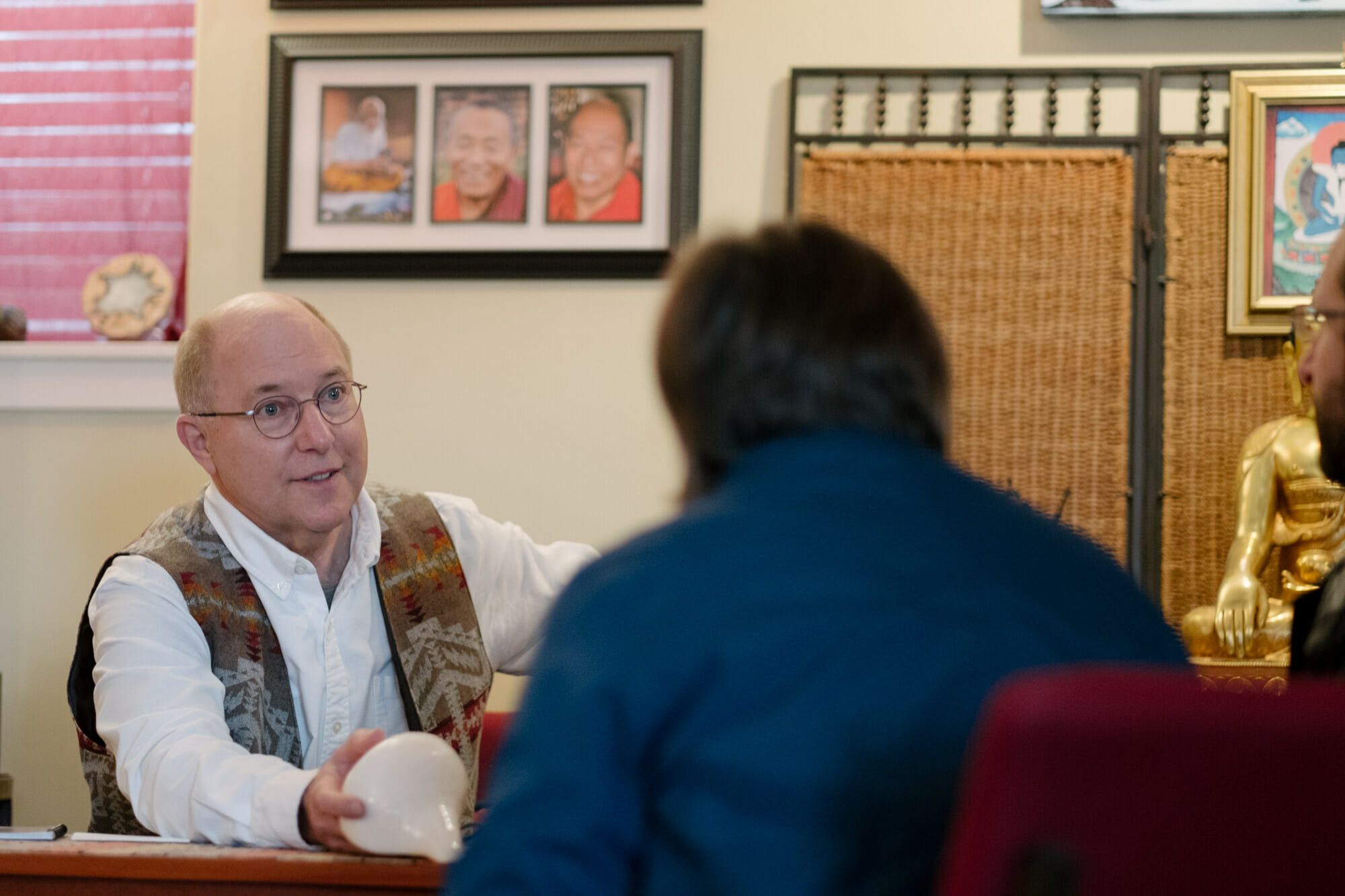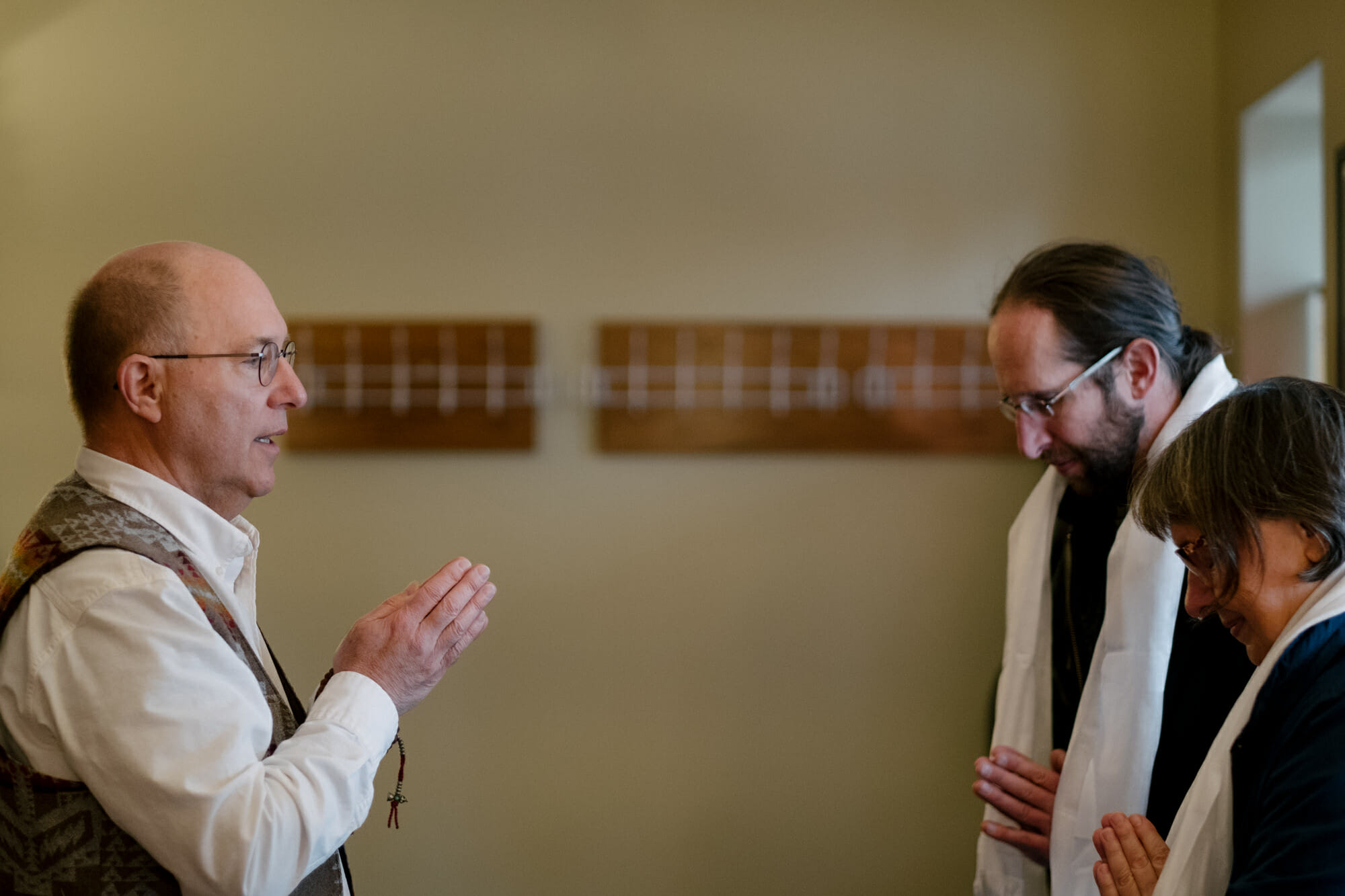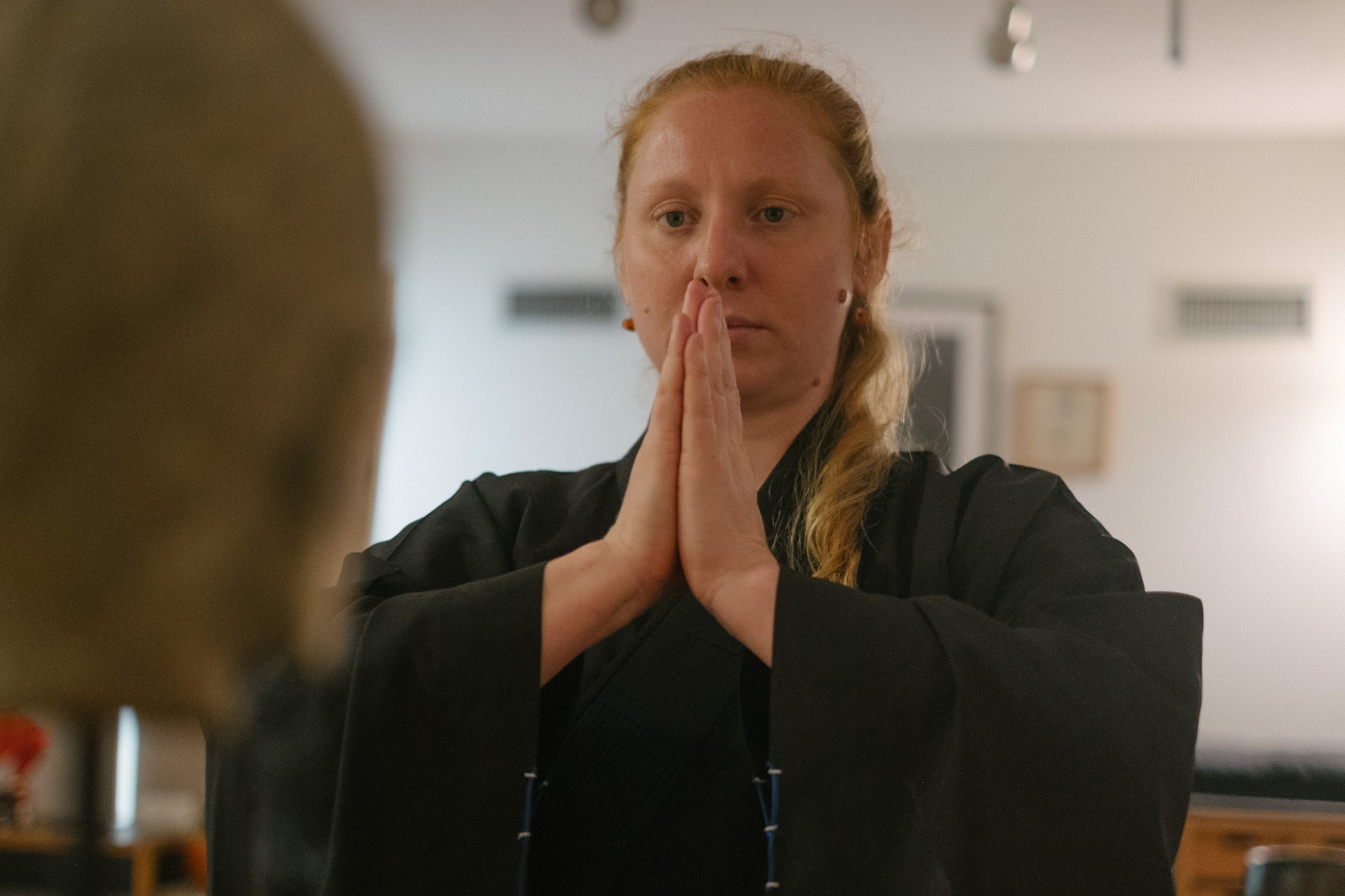Biography
“No sessions, no breaks.” This is a saying in the Vajrayana Buddhist tradition that seems to be the theme for my spiritual journey. I remember talking to ‘God’ when I was three years old. This was the language I heard around me, echoing from all natural phenomena and relationships. I knew it was about being present to the moment and connecting with something beyond my limited self. I spent a lot of time inside my introverted nature discussing reality with an unseen presence.
By third grade I wrote a paper on the “death of god” theology that was in the headlines. I thought it was a weird premise to state that a transcendent deity could experience death. So I humorously indicated God was actually alive at a hospital in St. Louis under an assumed name. My teacher thought I was a strange kid. She was right.
My interest in what drives people to a journey of self-discovery continued in high school when I made a short film about the individuation process. I called it “Roles and Jam”, referring to the masks we wear and how that false self gets us into so much trouble. Although I played the game of excelling as a student and finding myself in leadership positions in various school activities, a part of me was a detached observer. It was simply a mask I was wearing to be a part of the high school scene.
I was also interested in the scientific approach to what makes people tick. I began my college experience by majoring in biochemistry. Due to my academic performance in high school I was placed in advanced classes. I remember a moment in a biochem lab when I was isolating DNA from a desiccated rats liver. When I saw the slimy material dripping from the glass rod in my hand, I thought to myself, “What does this have to do with anything?” Later on, one of my roommates killed himself in our shared apartment. He literally blew his DNA all over the place. As I picked up pieces of brain from furniture and album jackets, I had an epiphany. I entered the Religious Studies program and graduated with a degree in Comparative Religions.
I went on to graduate study in theology and clinical psychology and took deacon ordination in the Methodist Church. In 1975, my seminary sent me as their representative the to the World Council of Churches meeting in Nairobi Kenya. My eyes were opened to the global church and how it was exported to places around the world. I saw how the power belief often superseded awareness of local needs (ie.missionary work) and experienced another epiphany. I created a multimedia production contrasting Christian ideals with the simplicity of native customs and practices.
I left seminary and decided to follow my inclinations toward meditation and inner direction. The journey took many paths with lots of twists and turns. I studied with a Hopi shaman, a Zen master, and engaged in various meditation practices. I eventually found a spiritual mentor in the yogic tradition and studied and practiced/taught yoga for many years. I was a licensed massage therapist with my own private practice. I even got certified to teach the in Enneagram tradition of personality awareness and development.
Finally, I went to a seminar taught by a couple of brothers who were Tibetan Buddhist masters and I was home. What they taught was inscribed upon my heart long before my parents were born. I recognized an echo, a trace of a long forgotten memory. What they taught was, “no sessions, no breaks.” I began to practice in the Nyingma lineage of Vajrayana Buddhism and never looked back.
As years went by, people began asking me to teach about Buddhism and, long story short, this led to the founding of the Natural Mind Dharma Center in Bend Oregon. I teach here and through the local community college. I also guest lecture at local high schools when they offer world religion courses. I am closely connected to the hospice community, offering classes on the Tibetan Book of the Dead and volunteering as requested to be present for the final breaths of some folks.
Now, backing up a bit, this entire journey played out on a backdrop of householder dharma. I have been married for more than forty-four years to a wonderful woman named Tarn. She has been a supportive partner along the way. I worked in many jobs: solar and woodstove sales and installation, an outdoor and sporting goods store, bookstore manager, wild bird shop sales (birdseed, feeders, etc.)—whatever it took to honor my end of the financial responsibilities. I found this work to be the best of all fields in which to practice moment to moment awareness.
This story is also framed by my primary practice of sojourning in the natural world. I always heard teachings emanate from rocks, plants, rivers, deserts, and mountains. These have been my main teachers. My wife and I are consummate wildflower and geology nerds. We take weekly hikes into the wilderness to identify the plants and geological features. Every bit of botany and geology mirrors a teaching about awareness. The dakinis of earth, water, fire, wind, and space, speak in echoes of the primordial mind.
My root teacher, Khenchen Palden Sherab Rinpoche who passed away in 2010, had the same connection with nature. They called him “hurricane” because, as a child, he would tear around the countryside laughing and enjoying the dance of untamed wilderness. I had a formal connection with the Padmasambhava Buddhist Center until he died. My current living teacher, Lama Rinchen Phutsok, also enjoys the natural world. When he travels here from Kathmandu, we often take hikes together.
My close lineage is Dudjom Tersar, beginning with Dudjom Lingpa, to Dudjom Rinpoche, to my personal teachers. There were many signs that pointed to this tradition, not the least being its connection to my mentor in the Christian world, Thomas Merton. Merton met my root teacher and spent an extended time with Chatral Rinpoche. I also had dreams of Dorje Drollo, a Nyingma deity/archetype, even before I met my Tibetan teachers.
My introverted nature and inclination to discover the true nature of mind as reflected in wilderness, lends itself well to the practices of Vajrayana. Moment to moment awareness of bodhicitta, the heart/mind of compassion, is reflected in natural cycles and tested in the realm of work and relationships. In particular, the non-graduated path of Dzogchen is a perfect example of practicing with “no sessions, no breaks,” and the Dudjom Tersar Ngöndro has all elements of this complete practice.
Background
Michael’s journey began with a profound connection to the natural world, viewing it as his primary teacher since childhood. Even at the age of three, he marveled at the hidden intricacies of the insect world beneath the grass. Early on, he developed a deep inquiry about the unseen aspects of life.
His fascination with theology emerged in third grade when he explored the concept of “death of God theology.” Writing papers and engaging in conversations with God became a common practice for Michael throughout his formative years. In high school, he chose to be baptized by choice, considering it an initiation into Christian teachings.
In college, Michael initially pursued biochemistry, driven by a scientific curiosity inherited from his family. However, a tragic event, his roommate’s suicide, redirected his focus toward inner sciences and human identity. This experience confirmed his decision to shift to religious studies, eventually earning a degree in comparative religions.
His exploration extended to Eastern traditions, particularly Buddhism, influenced by a professor of Japanese heritage. After entering seminary, Michael’s worldview expanded during a transformative experience at the World Council of Churches in Nairobi, Kenya. The dissonance between exported spirituality and native traditions led him to leave seminary.
Michael delved into Eastern traditions, studying with various teachers, including a yoga master who deeply influenced him. Becoming a certified yoga teacher and massage practitioner, he aimed to help others recognize the unseen energies that influence mind and body.
Encountering Buddhist teachings, specifically in the Vajrayana tradition, Michael delved into understanding the nature of the mind and one’s true self. The teachings prompted him to question the nature of perception and explore the interplay between thought and reality. The Buddhist tradition became a guide for settling the mind and recognizing one’s absolute identity.
Development
In contemplating the nature of clarity and classiness, Michael emphasizes that true understanding unfolds when seen through the eyes of love and assistance to others. Reflecting on a personal incident where he and his wife were hit by a distracted bicyclist, resulting in a shattered kneecap, Michael’s response was not guided by formal teachings but by a natural inclination towards compassion and understanding.
Despite the severe impact on his health, including a pulmonary embolism, Michael’s focus remained on the well-being of others. His approach extended to the EMT transporting him to the hospital, where he shifted the conversation from his own condition to inquire about her life. This act of selflessness led to a heartfelt exchange where the EMT shared the challenges of caring for her father with Alzheimer’s, a journey Michael himself had experienced with his own father.
Michael’s lessons in empathy and letting go of assumed realities were honed through caring for his father with Alzheimer’s, navigating the shifting landscapes of his father’s memories. In these moments, he learned the importance of embracing other people’s realities, listening attentively, and letting go of preconceived notions. For Michael, these practices constitute his daily life, transcending labels or specific teachings, and embodying the essence of genuine communication and compassion.
Lineage
Michael, acknowledging that he is not a formally trained lama, shares insights into Vajrayana practices, emphasizing the core practices rather than elaborate rituals. He highlights the holographic nature of rituals, where each piece contains the entire teaching, making everything valuable. While some rituals may seem overwhelming, Michael expresses great respect for them, recognizing their profound depth.
He delves into the creation and completion stages, describing the visualization practice as a means to understand how the mind projects and creates reality. Through the union of visualization (creation) and non-conceptual meditation (completion), practitioners merge the right and left brain functions, creating a holistic experience. Michael underlines the interconnectedness of light and sound, representing energy frequencies in quantum physics, aligning Buddhist principles with scientific understanding.
The practices lead to recognizing reality as dreamlike, encouraging practitioners to awaken both in nightly dreams and the waking state. Michael emphasizes the integration of spatial and linear aspects of the brain through these practices. He encourages embodying the visualized deity’s qualities, such as Green Tara, in daily life, perceiving the world as a field of enlightened intention. This perspective fosters a compassionate response to thoughts and emotions, allowing them to naturally serve the greater context of unconditional love. In Vajrayana, anger, for example, can be transformed into fierce compassion, redirecting negativity into positive actions. Michael finds this practice profoundly unique within Buddhism, offering a holistic and transformative approach to understanding and engaging with reality.
Teachers
Michael reflects on the common stumbling block people encounter on their spiritual journeys, highlighting the tendency to project unrealistic expectations onto traditions and teachers. He emphasizes that while teachers serve as mirrors, they are not the reason for awakening. Michael observes that fallen teachers often result from unrealistic projections and discusses the Dalai Lama’s critique of the grandiose portrayal of teachers.
He delves into the importance of recognizing one’s own face in the teachings and practices, emphasizing that the outer teacher is a reflection of one’s inner wisdom. Michael narrates a personal story of seeking advice from his yoga master about relationships, leading to the realization of non-attached interconnectedness. He contrasts the perspectives of Buddhism and yoga on the self, stating that yoga brings one to the precipice of self-awareness, while Buddhism makes the practitioner jump off the cliff into no-self.
Michael describes the teacher as a clear mirror, pushing practitioners to let go of attachments and expectations. He shares a pivotal moment in his life when the teachings of unconditional love were profoundly experienced through his relationship with his wife. Michael emphasizes that the teacher’s role is to remind and guide, often pushing practitioners beyond their comfort zones. He concludes by urging individuals to shift from practicing their dramas to embodying their dharma, aligning their actions with wisdom and direction.
Yoga
Even during his time as a yoga teacher, Michael observed that many people approached yoga primarily as a physical discipline, viewing it as another sport or body-oriented activity. While teaching, he experimented with removing music from his classes, finding that people’s reactions indicated a tendency to engage with yoga on a surface level rather than delving deeper into its spiritual aspects.
Michael shared his personal journey of feeling a deeper calling within yoga, akin to the echo he experienced as a child exploring nature beyond its surface. He highlighted the original intention of yoga, as demonstrated by his master who spent 14 years in silence, attaining a state called “nirvikalpa samadhi” or someone without seed. This level of enlightenment challenges the conventional way of living.
His yoga master emphasized that serious spiritual practice could disrupt traditional life, challenging individuals to move beyond their comfort zones and preconceived notions about reality. Michael noticed that people often struggle to take meditation and spiritual practices beyond a certain point due to the inherent challenges of stretching beyond conceptual limitations.
In the context of Buddhism, Michael mentioned the teaching that the concepts of Buddha cannot be held by the conceptual mind, emphasizing the difficulty of capturing the true nature of the mind and reality through mere ideas. He explained how his experience in the yogic traditions shook his ideas about reality, and when he encountered his Tibetan Buddhist teachers, their framework provided him with a clearer understanding and allowed for more profound realizations.
Personalities
In his reflections, Michael discusses the diverse appeal of Buddhism, acknowledging that specific personality traits or preferences don’t necessarily define those drawn to a particular style. He shares his teaching approach, noting that people appreciate it regardless of their connection to specific Buddhist traditions. His observations range from seasoned practitioners, older individuals, and families with children, including younger practitioners.
Michael emphasizes the timeliness of the teachings, particularly in the context of the natural great perfection, suggesting that these non-graduated paths suit the changing times and the swift pace of modern life. He mentions the correlation between Western science and Buddhism, highlighting studies on monks’ neuroplasticity.
The teaching approach involves immediate results, making it different from traditional causal vehicles. Michael humorously refers to a group he calls “recovering Catholics,” individuals who find resonance with the ritual aspects of Buddhism. He discusses the adaptability cultivated through meditation practices and the Dalai Lama’s interest in science.
In the final part, Michael introduces the concept of a technology of awakening, illustrating the power of repetition, mantra, and anchoring intentions. He explains the shift in Western expressions of Buddhism, bridging the gap between tradition and the pragmatic inquiries of the Western mind.
Natural World
In reflecting on his relationship with his wife, Taryn, Michael shares the origin of their connection during a backpacking trip through the Central Cascades, Olympic Peninsula, and the Olympic Mountains in Washington, as well as Oregon. Their bond developed through a shared interest in identifying geological features and flowers, cultivating a naturalist perspective over time. They became partners in camping and hiking, valuing the journey over reaching specific goals.
Michael draws parallels between their outdoor experiences and Buddhist teachings, emphasizing the significance of the journey and the wisdom found in nature. He discusses how the natural world serves as a mirror for Buddhist principles, such as the analogy of a moon’s reflection in a lake, making conceptual teachings more visceral and embodied.
Sharing a pivotal dream from many years ago, Michael recounts climbing a mountain and realizing the impact of his actions on the stones he kicked away, affecting others’ journeys. This dream teaches him the importance of compassion and helping others find stable footing on their own paths, reminiscent of the Buddhist tradition’s emphasis on interconnectedness and compassion.
Michael concludes by highlighting the wisdom embedded in the elements of earth, water, fire, wind, and space, both in the natural world and within ourselves. He stresses the importance of learning from nature and recognizing its role as a reflection of our original context and mind.















































































